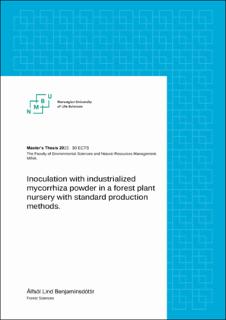| dc.contributor.advisor | Line Nybakken | |
| dc.contributor.advisor | Isabella Børja | |
| dc.contributor.advisor | Inger S. Fløistad | |
| dc.contributor.author | Benjaminsdottir, Alfsol Lind | |
| dc.date.accessioned | 2023-09-08T16:27:14Z | |
| dc.date.available | 2023-09-08T16:27:14Z | |
| dc.date.issued | 2023 | |
| dc.identifier | no.nmbu:wiseflow:6872776:55141273 | |
| dc.identifier.uri | https://hdl.handle.net/11250/3088380 | |
| dc.description.abstract | Skogreising på Island står nesten kun av planting av planter fra planteskoler. På landsbasis ligger gjennomsnittlig overlevelse i felt på under 50%. Muligheten for å øke overlevelsen ved å inokulere plantene med mykorrhiza sopp under produksjonen er en lite studert mulighet. I dag er inokulering ikke del av standardisert skogplanteproduksjonen i Island. Formålet med denne oppgaven er å se om inokulering kan innlemmes i standardisert produksjon. Påvirkning av tre behandlinger – inokulering, gjødsling og bruk av fungicider – på mykorrhisering, tilvekst og rot formasjon ble undersøkt. iada
Lerkeplanter (Larix sibirica) (N = 1608) ble inokulert på to ulike tidspunkter med et industrielt mykorrhiza-pulver. Elleve og åtte uker etter inokulering ble vekst til plantene målt, samt mykorriserings grad vurdert visuelt. Dessuten ble rotegenskaper hos inokulerte og ikke inokulerte planter undersøkt i WinRHIZO rot skanner. Individuelle og kombinerte effekter av behandleringer ble undersøkt.
Inokulering økte mykorrhisering i plantene, mens gjødsling reduserte mykorrhisering. Inokulerte planter hadde lavere høyde og rothalsdiameter sammenlignede med ikke inokulerte planter. Lav gjødsling mengde reduserte også høyde og rothalsdiameter, mens det var lite forskjell i vekst mellom middels og høy gjødslingsmengde. Dersom multikollinearitet oppstå mellom gjødsling og fungicider, ble effekten av fungicide på både mykorrhisering som vekst umulig å tolke. Kombinerte effekter av gjentatt inokulering og middels gjødslingsmengde ga høyest mykorrhiserings-grad hos plantene. Inokulering hadde ikke en signifikant effekt på root-egenskaper, derimot indikerte resultatene fra WinRHIZO røtte-skanneren, e.g., antall rot spisser, at inokulering hadde lykkes.
Denne oppgaven viste å det er mulig å inkorporere mykorrishering til standardisert produksjon av skogplanter i planteskoler. Dersom mykorrhisering var generelt lav trengs videre forskning på ulike kombinasjoner av faktorer som påvirker inokulerings graden. | |
| dc.description.abstract | Icelandic afforestation is almost completely limited to planting of seedlings. On a national scale, the overall survival rate for seedlings in the field is below 50%. An understudied possibility to increase survival in the field is inoculation of mycorrhiza in the forest nursery, but inoculation is presently not a part of the standard production. The aim of this study was to investigate if incorporating mycorrhizal inoculation into the standard nursery production was possible by testing how three factors — inoculation, fertilization, and the use of fungicide —affected mycorrhizal colonization, growth, and root morphology of Larix sibirica seedlings.
Seedlings of Larix sibirica (N = 1608) were inoculated with an industrialized mycorrhizal soluble at two different time points: germination and visible fine root production. Eleven and eight weeks after inoculation treatments, seedling growth was measured and mycorrhization visually estimated. At the same time, the root traits of inoculated vs. uninoculated seedlings were examined with a WinRHIZO scanner. Individual as well as combined effects of the treatments were examined.
Results showed that inoculated seedlings increased their mycorrhization, while fertilization decreased mycorrhization. Inoculated seedlings had a lower height and stem diameter compared to untreated ones. Low fertilization decreased height and stem diameter, while there was little difference between medium and high fertilization. As multicollinearity occurred between fertilization and fungicide in a regression analysis, the effects of fungicide on mycorrhization as well as height could not be interpreted. Combined effects showed that repeated inoculation and medium fertilization gave the highest mycorrhization. Inoculation did not significantly affect root traits. However, root traits, such as the number of root tips, indicated that mycorrhization had been successful.
This study contributes to an increased knowledge about the possibility of incorporating inoculation of mycorrhiza into the standard nursery production of seedlings. Further studies are needed to address remaining questions about the relationship between repeated inoculation and fertilization levels. | |
| dc.language | eng | |
| dc.publisher | Norwegian University of Life Sciences | |
| dc.title | Inoculation with industrialized mycorrhiza powder in a forest plant nursery with standard production methods. | |
| dc.type | Master thesis | |
